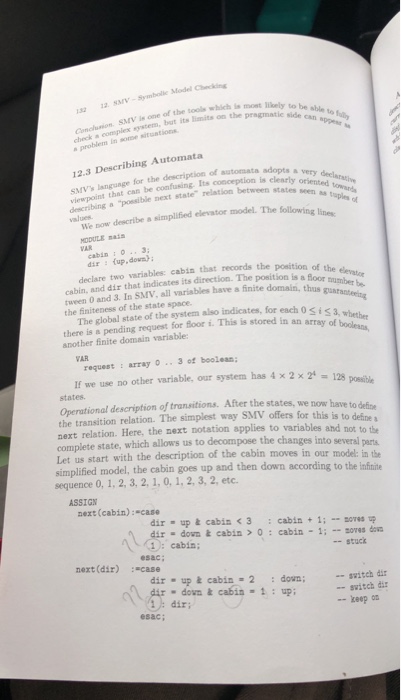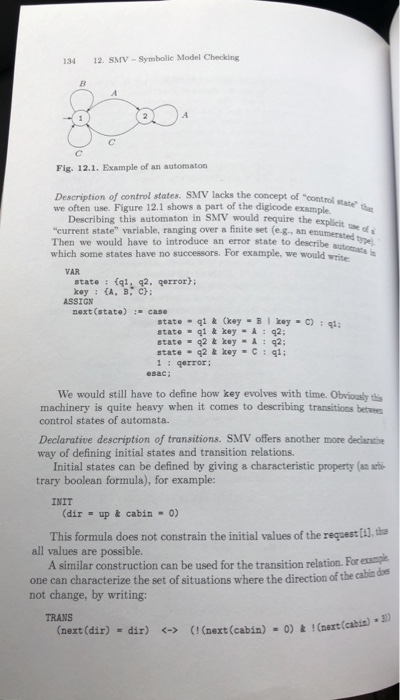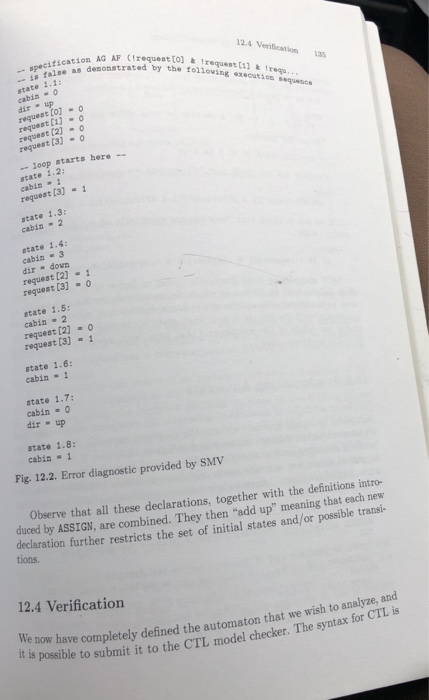Answered step by step
Verified Expert Solution
Question
1 Approved Answer
Could you please explain the lines of code found in those pages ( those is written in JSpin) The last 10 lines in this page
Could you please explain the lines of code found in those pages ( those is written in JSpin)
The last 10 lines in this page 
lines of code at the middle and at the end of page

lines of code at the middle and the end of this page

lines of code at the beginning of the page

12. san-Symbolic ModelOucking be sble to full SVV is one of the tools whleh s most likely to but its limits on the pragmatlc side can a problem In some situntions 12.3 Describing Automata SMVs langunge for the description of automata adopts a Sewpoint that can be confusing. Its conception is clerly w decl diesecribing a "possible nest state" relation between state oriented between states seen s tuples of We now describe a simplified elevator model. The followine VAR cabin : O.3 dir : (up.down two variables: cabin that records the position of the declare two variables: cab cabin, and dir that indicates its direction. The tween 0 and 3. In SMV, all variables have a finite domain, thusb position is a floor umber b the finiteness of the state space The global state of the system also indicates, for eachOsisa there is a pending request for floor i. This is stored in an array of booleans another finite domain variable: WAR request array 3 of booleam If we use no other variable, our system has 4 x 2 x 24 125 states. Operational description of transitions. After the states, we now have to the transition relation. The simplest way SMV offers for this is define to define a to variables and not to the parts in th next relation. Here, the next notation applies complete state, which allows us to decompose the changes into several Let us start with the description of the cabin moves in our model: simplified model, the cabin goes up and then down according to the infinite sequence 0, 1, 2, 3, 2,1, 0, 1,2,3, 2, etc. ASSIGN next (cabin):-case dir . up & cabin 0 : cabin 1; sores d -- stuck esac: next (dir) :case dir up cabin - 2 doun - down & cabin -:upi -switch dir switch d xeep o dir esac; 12. san-Symbolic ModelOucking be sble to full SVV is one of the tools whleh s most likely to but its limits on the pragmatlc side can a problem In some situntions 12.3 Describing Automata SMVs langunge for the description of automata adopts a Sewpoint that can be confusing. Its conception is clerly w decl diesecribing a "possible nest state" relation between state oriented between states seen s tuples of We now describe a simplified elevator model. The followine VAR cabin : O.3 dir : (up.down two variables: cabin that records the position of the declare two variables: cab cabin, and dir that indicates its direction. The tween 0 and 3. In SMV, all variables have a finite domain, thusb position is a floor umber b the finiteness of the state space The global state of the system also indicates, for eachOsisa there is a pending request for floor i. This is stored in an array of booleans another finite domain variable: WAR request array 3 of booleam If we use no other variable, our system has 4 x 2 x 24 125 states. Operational description of transitions. After the states, we now have to the transition relation. The simplest way SMV offers for this is define to define a to variables and not to the parts in th next relation. Here, the next notation applies complete state, which allows us to decompose the changes into several Let us start with the description of the cabin moves in our model: simplified model, the cabin goes up and then down according to the infinite sequence 0, 1, 2, 3, 2,1, 0, 1,2,3, 2, etc. ASSIGN next (cabin):-case dir . up & cabin 0 : cabin 1; sores d -- stuck esac: next (dir) :case dir up cabin - 2 doun - down & cabin -:upi -switch dir switch d xeep o dir esac
Step by Step Solution
There are 3 Steps involved in it
Step: 1

Get Instant Access to Expert-Tailored Solutions
See step-by-step solutions with expert insights and AI powered tools for academic success
Step: 2

Step: 3

Ace Your Homework with AI
Get the answers you need in no time with our AI-driven, step-by-step assistance
Get Started


